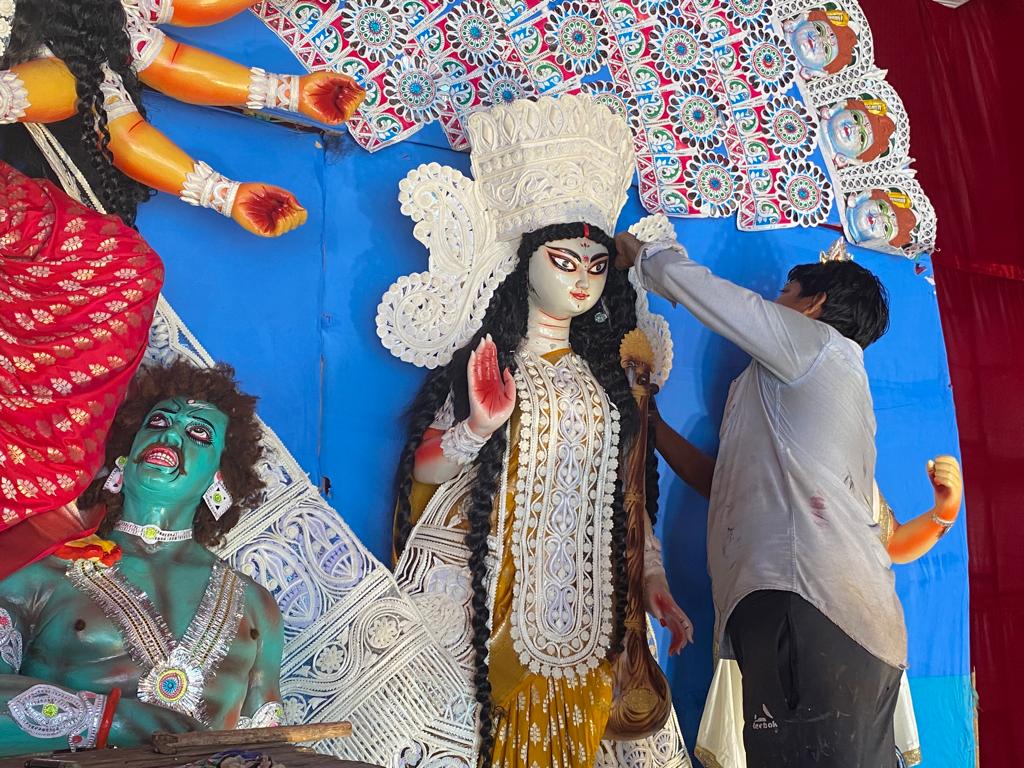Durga Puja 2022: Smaller idols to eco-friendly visarjan, insight into how celebrations changed post Covid
Sep 28, 2022

By Yash Kumar
New Delhi [India], September 28 : Durga Puja or Durga Pujo as it is famously called is just around the corner, and the preparations for the festival have begun in full swing in Delhi.
After a hiatus of 2 years, the celebrations of Durga Puja will begin on October 1 this year. But with some slight changes.
Post Covid, the committee members of various pandals at CR Park, Delhi have been instructed not immerse the idols of Goddess Durga in the river Yamuna. Due to this, the size of Goddess Durga's idols has become smaller in some areas.
Partha Banerjee, Committee member at CR Park Delhi, in conversation with ANI, said, "The MCD, Police and the Horticulture department have created small pits over CR Park to immerse the idols for everyone, and for those who are using the pits created by MCD are being instructed not to create Durga idols more than 5ft. But here we have dug up our own pit behind the pandal for the immersion so we can create the idol as tall as we want to."
Ashish Shome, Treasurer, Azadi Ka Amrit Mohatsav-themed pandal, CR Park, said," There are no such orders to decrease the size of idols, but now we can't immerse the idols in Yamuna river, so everyone has to do immersion at their own place and the government have created small pits for us so we have to immerse the idols there. So there are no restrictions on the size of the idol, but because we cannot immerse the idol in the Yamuna river, we opted to create smaller idols this year."
Sameer Banerjee, General Secretary, Durgotsav GK 2, told ANI, "Due to covid-19, for the past few years we were not able to celebrate the festival at a massive scale, but now we are back. We got an instruction to decrease the size of Maa Durga idol, it should have to be around 8ft. at the pandal, so we followed that instruction. I don't know if that rule is valid now or not. We are going with eco-friendly idols made up of clay and are instructed to end the celebrations by 10 PM every day."
On being asked about the excitement among the devotees for the festival, Partha Banerjee said, "Before Covid, we usually had a footfall of over 1 lakh people every day, even more than that on Ashtami and Navami. But this year we just can't imagine how massive it's gonna be. But we are prepared for that and we are taking all the precautionary measures. We have our own bouncers and police support."
Sameer Banerjee told ANI, "Due to a hiatus of 2 years, devotees were not able to celebrate Durga Puja, but now we are all excited. Our Durga Aarti is very famous, around 2000-3000 devotees gather here during the aarti."
Professor Anand, Committee member, in conversation with ANI said, "After corona we have bounced back like anything, you have to feel the thing at the Pandals. You will see how devoted people are, how enthusiastic they are. Young, old, men, ladies they are all working day and night and it will be something spectacular this time."
The Hindu festival of Durga Puja, also known as Durgotsava or Sharodotsava, is a yearly celebration that honours the Hindu goddess Durga and commemorates her victory over Mahishasur.
To destroy Mahishasura, Goddess Durga appeared from the fusion of all the gods' energies in heaven. She had ten arms, and on each of them, she carried the most lethal weapon belonging to each God. All of Goddess Durga's weapons are sanctified during this time.
Over the years, Durga puja has become an inseparable part of Indian culture with innumerable people celebrating this festival in their own unique way while pertaining to tradition.
Hindu mythology holds that the goddess comes to her earthly abode at this time to bless her devotees. For the Bengali community, Durga Puja is the biggest festival. This year Maha Shashti falls on October 1 and Vijaya Dashami on October 5.
The significance of Durga Puja goes beyond religion and is revered as the celebration of compassion, brotherhood, humanity, art and culture. From the reverberation of 'dhaak' and new clothes to delicious food, there remains a merry mood during these days.
In other parts of the country, during the nine-day Navratri festival, devotees worship Maa Durga's nine incarnations in order to obtain her blessings. There is a goddess manifestation linked with each day of Navratri.
During these nine days, people maintain ritualistic fasts, recite shlokas dedicated to each goddess, wear new clothing, offer bhog, and clean their homes. In their prayers, they ask the goddess for her favour in order to have prosperous, joyous and fulfilled lives.




















